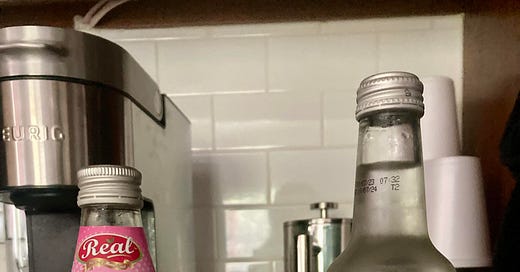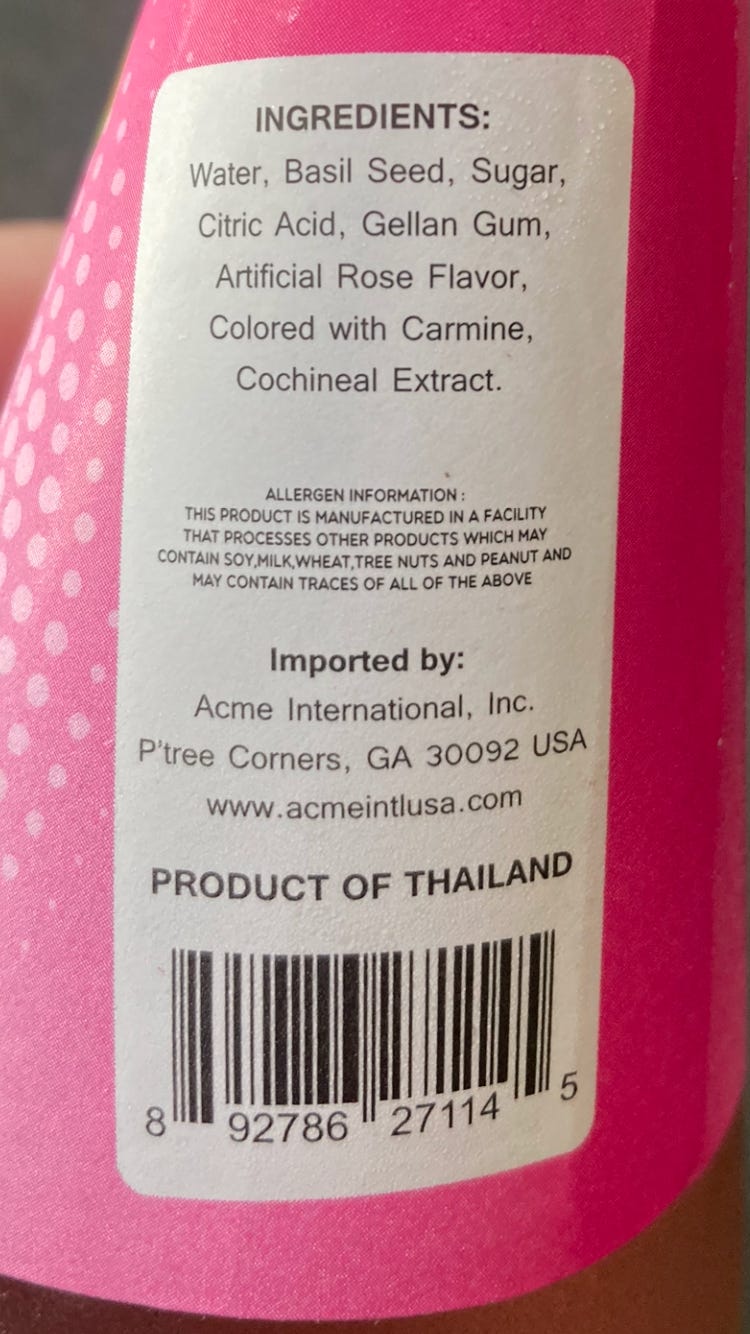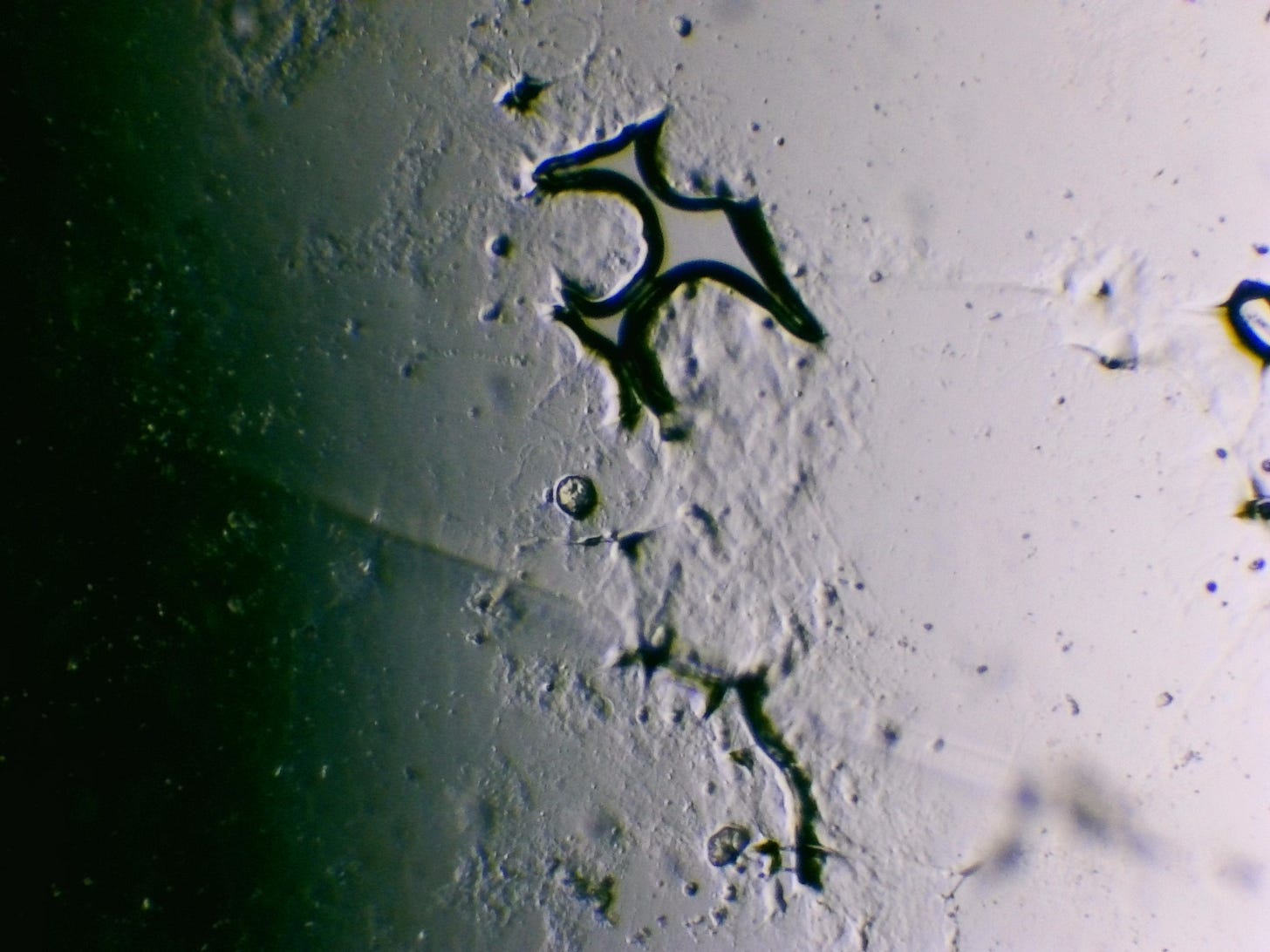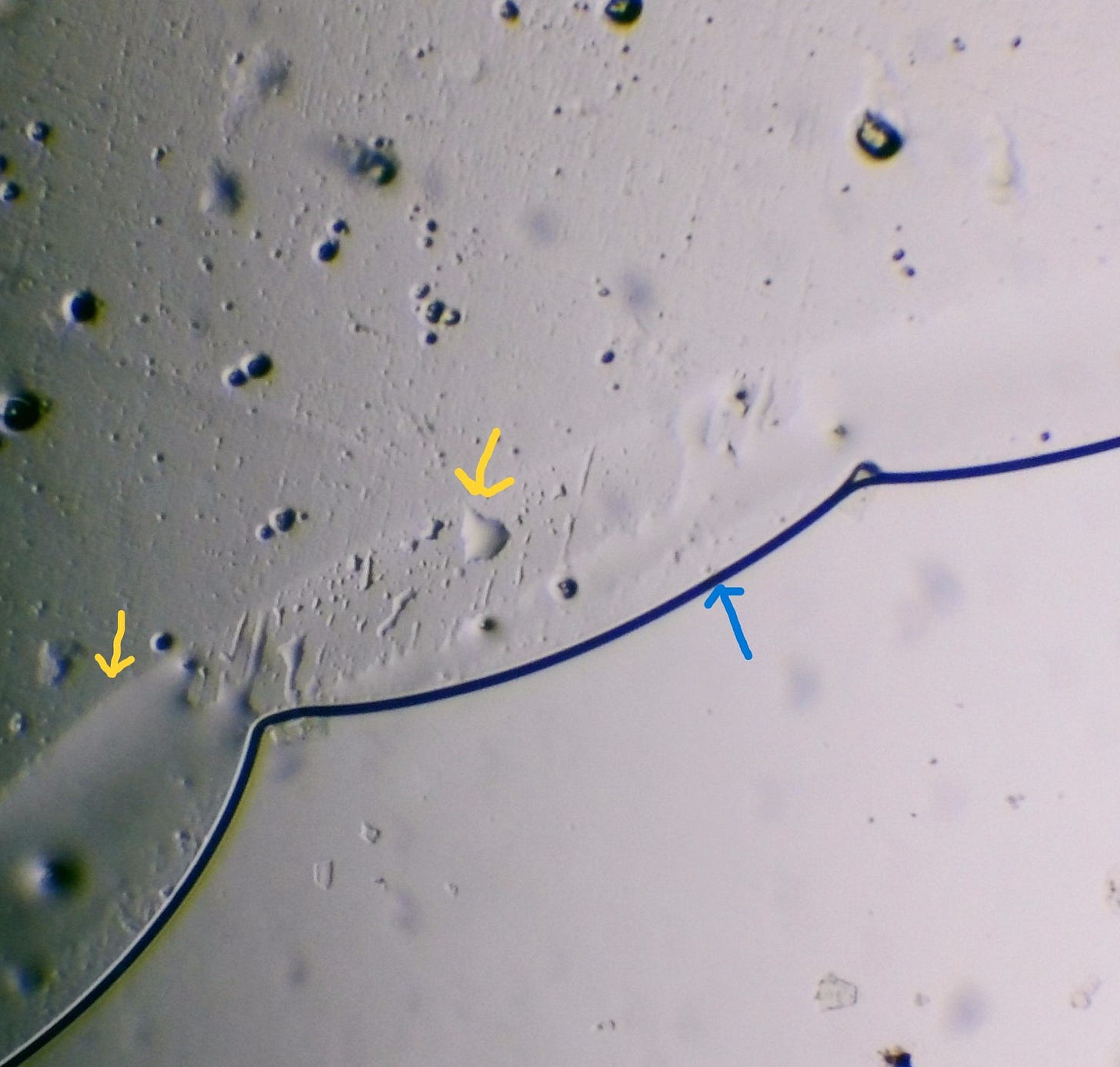I was in an international grocery store the other day and it dawned on me that I could find all sort of things to sample there that might give me some insight into how dispersed the nanotech is throughout the world. It’d be fascinating to have a look into meat from various countries. But to start off I’ll stick to simple liquids. I grabbed a handful of beverages that were bottled in three different countries.
The “rose water” was bottled in Thailand.
The “iced latte” is a mix of instant coffee, cow milk and buffalo milk from India.
And finally the Mexican drink is simply carbonated water without sugar or other ingredients and additives.
As often happens when looking at samples under the microscope, I didn’t see evidence of nanotech until about two weeks in. The first few days everything looked normal. Then I stepped away for another couple weeks and kept the samples covered in a cool, dark place.
I’m happy to report that I didn’t see anything unusual in the Mexican soda :) Even if it’s just carbonated water, it’s still a good sign that not every source of water on earth is heavily contaminated.
The Indian coffee, which primarily consists of buffalo and cow milk, did unfortunately show some signs of nanotech contamination. From what I understand, India did not use Pfizer, Moderna, or any other American brand vaxx and used a non-American manufacturer to make their own version of a c*vid vaxx. But of course this does not exclude the possibility that the same nanotech nonetheless ended up in their locally manufactured vaxx. And of course there are a million other ways the tech can be introduced into their local livestock, such as other routine vaxx’s.
As usual, there was tons of hydrogel, and it was forming into patterns that are similar to other samples I’ve looked at, yet also quite distinct with new patterns I haven’t seen before. I’ve noticed that the patterns hydrogel forms can vary wildly depending on the substance it is distributed through. Sometimes the patterns are as simple as wavy lines; more often I see a combination of wavy lines and serrated edges; and more rarely I see more complex, almost plant-like patterns that seem organic and technological at the same time. (Hopefully I’ll be ready to do a deep dive post on hydrogel soon. I’ll need to review all the available research here on Substack first.)
So here are some images of the distinct patterns of hydrogel that formed in the Indian coffee. The first image is brightfield and the rest are DIY darkfield/oblique partial lighting. The first brightfield image is a simple pattern very typically seen in many samples, and in the darkfield you can see some more complex patterns that look more or less like vines, for lack of better description.
There were some fibers here and there, but they weren’t as numerous, as large/long or as well-developed as what I see in other samples with hydrogel. I don’t yet have a working theory as to why the fibers are sometimes very large and “active” in some samples but not in others. When “active” or at least more active, the fibers vary widely in color and have “quantum dots” inside that move and/or blink with light. When not as active, they are much smaller in size (usually less than one third of my total screen size with 4x objective) and remain clear or brownish in color. I realize I need to figure out how to get more specific size measurements, so I’ll try to work on that later this week.
Another noteworthy aspect of the Indian coffee sample was tube networks similar to what I found in my saliva samples. However, these networks were comparatively sparse and faint in comparison to the saliva. They did not appear to be well-developed and were more ghostly in appearance. I drew some blue arrows to help you see the ghost tubes, though it’s still quite faint and hard to see even when you know where to look. I don’t think the faintness of the image is due to lighting since I experimented with brightfield and darkfield and magnification levels. I think it has more to do with not being fully formed tubes. Another possibility is that the tubes formed quickly and then dissolved or dissipated.
Come to think of it, these tube networks are quite similar to what I was seeing in my blood sample as well. When I first saw these types of structures, I didn’t immediately think of tubes. I thought of antennas and wires. Though I guess they are somewhat related.
The fact that these tubes are forming not just in my own biology, but in an internationally sourced product as well, hints that their formation may have something to do with the electromagnetic environment of my home. Perhaps something to do with how the wifi is setup or what kind of appliances are in the house. I hardly know anything about electronics, so it’s a complete guess on my part. A more paranoid and conspiratorial view could be that some type of signal is being beamed towards me. Though that seems like too far of a stretch. As far as I know, no other researchers have seen these tube networks in their own samples. Please let me know what you think in the comments.
And lastly, the Thai rose water. Evidence of hydrogel was found mostly at the edges of slide. There were not many ribbons here either, and the ribbons were smaller/not as developed as in other samples. While most of the evidence of the hydrogel was visible at the edges of the slide, there were hints that the hydrogel was likely thoroughly distributed across the slide but just didn’t form into the usual patterns and shapes.
Google provides a nice “AI overview” description as to how hydrogel can be evenly dispersed across a glass surface: “Hydrogels are polymeric materials that can absorb and retain a large amount of water, up to a thousand times their dry weight. The water molecules in a hydrogel are trapped within a 3-D network of pores, and the hydrogel's structure is compact because of the water molecules. The water molecules stick to the hydrogel polymer, causing it to open up and thicken, making the solution more viscous and sticky.”
So basically, hydrogel merges with the available water of a sample, which makes it difficult to discern its presence in any sample containing water (most samples). The “more viscous and sticky” nature of hydrogel-water solutions might help explain some of the shapes and structures we see, particularly where it’s wrinkly like a fabric which you can see in the linked post if you scroll to the bottom of that post.
Since hydrogel merges with water, it’s not surprising that it’s difficult to tell the water apart from the hydrogel until patterns, tubes, and other structures start to form. In the Thai rose water, it looks to me as though the hydrogel is spread thinly over the whole sample together with the water, with small shapes or small patterns emerging only once in a while.
Below are some photos that were characteristic of what was in the center part of the slide.
Here, it almost looks like a ribbon is trying to form where the edges of hydrogel gel plates meet. Or perhaps it is already a fully formed ribbon. It is hard to tell.
I think here, it’s pretty clear that a full ribbon has formed:
It’s interesting to note that the edges of merging hydrogel plates can form into either tubes or ribbons. Is a ribbon merely a partial tube, or vice versa? Though so far, the tubes have a very different structure than the ribbons and lack “quantum dots” inside of them, as far as we know. Hydrogel can also form into chip structures, which somehow seems related to the presence of fully formed and activated ribbons.
In the Thai rose water, I noticed only one small spot with rudimentary tube structures, which you can see in the video below. I think it’s likely that all of the larger shapes within the hydrogel eventually condense into either a tube or ribbon, assuming they converge close enough together to form a structure.
While most of the hydrogel seemed thinly and smoothly spread across the rose water slide with only an occasional ribbon or tube forming, the hydrogel at the edges of the slide was more visibly distinct. Hydrogel has thickness, structure, and sharply defined boundaries and edges that are not characteristic of water. Water has soft edges that look like… well, water. Below, yellow arrows point to water and blue arrows point to the edge of a hydrogel sheet.
Since I always place a drop of sample at the center of the slide, it seems like the hydrogel got pushed out from the center and just didn’t make it to the edges of the slide. Hence the fanned out appearance at the edges. However, it could be more likely that the hydrogel pulled the liquid of the sample away from the edges and towards the center as it dried and increased in viscosity.
That covers just about everything I wanted to discuss for this post. This blog is geared mainly towards other nano researchers and so I write in a way that is more accessible to them. It assumes that the reader has a strong familiarity with the topics covered. Unhackable Animal recently did a really excellent overview of all the major topics that is a great introductory point for newbies and casual readers.
Hope you enjoyed this post and found it informative. Let me know what you think in the comments. I’m going to give EDTA chelation a try soon. Ana Mihalcea recommends EDTA together with IV vitamin C. I’ve been wearing neodymium magnets, but so far haven’t noticed much improvement. My symptoms are mild tiredness and general inflammation. It could be so, so much worse, and I’m so grateful that my daily activities aren’t hindered in any way.
I’ve been sleeping a lot better ever since I learned how to really meditate. I’ve recently developed an interest in Tarot just in the last month or so. I didn’t realize until now that I actually have quite a lot of esoteric abilities. I’ve always collected crystals and used sage and divinatory teas and I spend a lot of time in nature, but for whatever reason, never connected it to everything else until my vacation, which was a weird experience in and of itself. I feel a strong pull towards the beach and the ocean now. Despite all of my analytical tendencies, I think leaning more into my intuition is going to provide more answers and better information.


















Good Work!...Good news about the Mexican bubbly water, and too bad about the other products. That is a great research project. I wonder if some of the 'oily' bubbles in the Rose Water is the Rose Essential Oil? (Not the obvious line of Hydrogel). I've noticed something similar when a product lists "glycerine", to not mistake it for Hydrogel. And OMG, did you catch what the pink color is made from? Insects! Thanks for the reference to my Field Guide Post! : )
Hello Michelle.w's,
You can look where you like its everywhere and in everyone. What has to be done is find a way to interrupt NT developement in the human body. Many are working on just that. RR